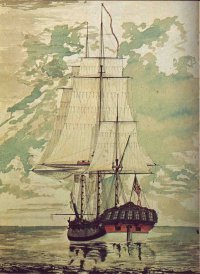Sailing the Seas With Horatio
Today's blog, on reading the C. S. Forester "Hornblower" books (after watching the A & E series with Ioan Gruffudd) appears on Book View Cafe. Here's the beginning...
 I've
I've
been reading the C. S. Forester "Horatio Hornblower" novels, one after
the other. It's really my husband's fault. He's usually extraordinarily
recalcitrant about watching movies, whether at home or in a theater. One
Friday night, he indicated his willingness to consider it, so we looked
over the DVD collection and embarked upon the A & E "Hornblower"
series at the sedate pace of one-episode-per-week. (Of course, we did
not stop there, but proceeded to Master and Commander and the
1951 Hornblower movie with Gregory Peck and Virginia Mayo.) For those
who have not had the pleasure of reading these stories, Horatio
Hornblower is a fictional naval officer during the Napoleonic Wars.
Actual events and personages are woven into the tales, although Forester
takes care that the exploits of his hero do not alter history.
As visually appealing as the films are, we immediately reached for
the books. I'd read a few of them many years ago, but never had the
experience of moving from one adventure to the next, watching the
maturation not only of the titular character but of the author.
C. S. Forester must have been quite a character. After writing
propaganda for Britain during WW II, he came to Hollywood to write the
script for a pirate film. Before he could finish it, the Errol Flynn
movie Captain Blood came out, effectively stealing the thunder
from Forester's project. To make matters worse, Forester was facing an
impending paternity suit (I am not making this up — it's from
the biographical notes at the end of the Back Bay Press editions), so he
"jumped aboard a freighter bound for England." He spend the voyage
outlining the first of the Hornblower novels, Beat to Quarters (The Happy Return), which was published in 1937.
.... for more, click on over to the Book View Cafe blog...


 I've
I'vebeen reading the C. S. Forester "Horatio Hornblower" novels, one after
the other. It's really my husband's fault. He's usually extraordinarily
recalcitrant about watching movies, whether at home or in a theater. One
Friday night, he indicated his willingness to consider it, so we looked
over the DVD collection and embarked upon the A & E "Hornblower"
series at the sedate pace of one-episode-per-week. (Of course, we did
not stop there, but proceeded to Master and Commander and the
1951 Hornblower movie with Gregory Peck and Virginia Mayo.) For those
who have not had the pleasure of reading these stories, Horatio
Hornblower is a fictional naval officer during the Napoleonic Wars.
Actual events and personages are woven into the tales, although Forester
takes care that the exploits of his hero do not alter history.
As visually appealing as the films are, we immediately reached for
the books. I'd read a few of them many years ago, but never had the
experience of moving from one adventure to the next, watching the
maturation not only of the titular character but of the author.
C. S. Forester must have been quite a character. After writing
propaganda for Britain during WW II, he came to Hollywood to write the
script for a pirate film. Before he could finish it, the Errol Flynn
movie Captain Blood came out, effectively stealing the thunder
from Forester's project. To make matters worse, Forester was facing an
impending paternity suit (I am not making this up — it's from
the biographical notes at the end of the Back Bay Press editions), so he
"jumped aboard a freighter bound for England." He spend the voyage
outlining the first of the Hornblower novels, Beat to Quarters (The Happy Return), which was published in 1937.
.... for more, click on over to the Book View Cafe blog...

Published on November 15, 2011 10:52
No comments have been added yet.



